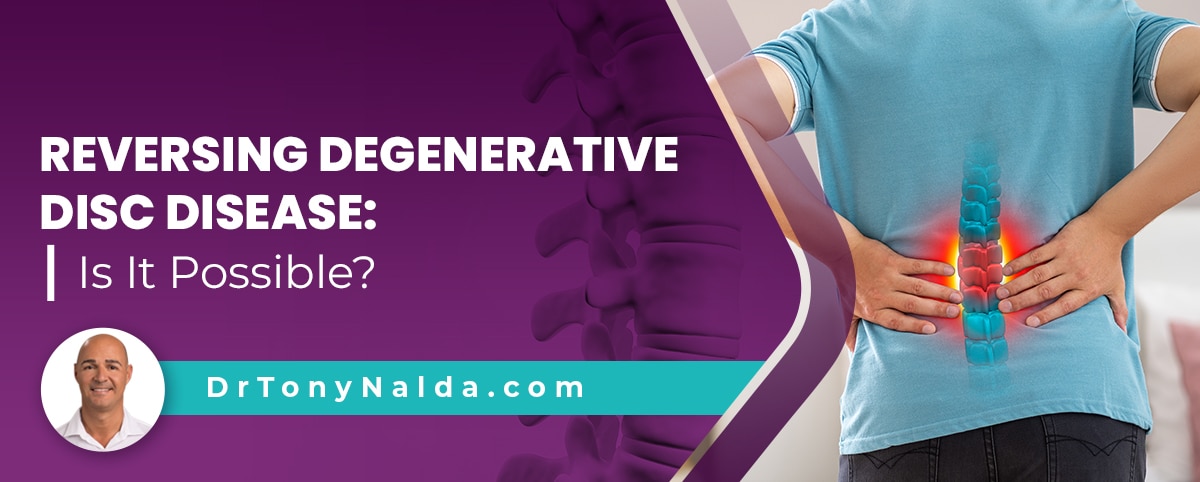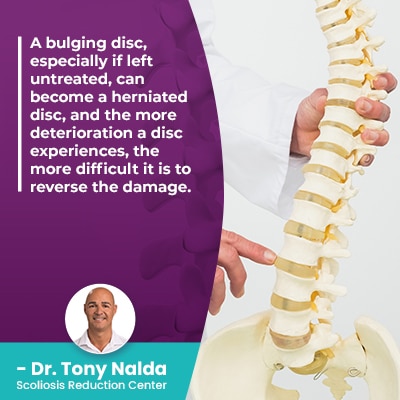Reversing Degenerative Disc Disease: Is It Possible?

The spine's intervertebral discs are generally the first spinal structures to feel the effects of degenerative changes, and degenerative disc disease can cause a number of issues and symptoms; continue reading to find out why reversing degenerative disc disease can be a lengthy process, why a full reversal isn't always possible, and how improvements can still be made.
Degenerative disc disease develops slowly over time, often caused by natural age-related spinal degeneration, and the process of reversing it can be as lengthy. Disc degeneration is difficult to fully reverse because the spinal discs don't have their own blood supply, but improvement is possible.
Before exploring the process of reversing degenerative disc disease, let's take a close look at the many important functions the discs facilitate.
Table of Contents
Intervertebral Discs
The basic structure of the spine contains three main sections: cervical spine (neck), thoracic spine (middle/upper back), and lumbar spine (lower back).
Each section consists of vertebrae (bones of the spine) that, in a healthy spine, are rectangular in shape and stacked on top of one another in a straight and neutral alignment.
Adjacent vertebrae are separated by an intervertebral disc in between, and the discs are made up of two main structures.
 Intervertebral discs have a soft gel like center, called the nucleus pulposus, which is encased in a tough and durable outer layer, called the annulus fibrosus.
Intervertebral discs have a soft gel like center, called the nucleus pulposus, which is encased in a tough and durable outer layer, called the annulus fibrosus.
The discs are made up of collagen, water, and proteoglycans, with the nucleus pulposus having the higher concentration.
So now that we know a bit about the structure of the spinal discs, what do they actually do?
Understanding Degenerative Disc Disease
When it comes to understanding the process of how to reverse degenerative disc disease, a comprehensive understanding of how the discs impact spinal health and function is key.
The discs of the spine perform many important roles, including acting as the spine's shock absorbers to absorb/distribute mechanical stress, combining forces to facilitate flexible movement, and providing the spine with structure as adjacent vertebrae attach to the disc in between.
When it comes to structural changes within the spine, many of these are due to changes to a disc's shape, health, function, and fluid level.
If a disc starts to degenerate and changes shape as a result, it can affect the position of nearby vertebrae and cause a disruption to the spine's natural and healthy curves and alignment.
Disc degeneration can involve:
- One or more discs drying out and shrinking
- One or more discs getting thinner and stiffer
- Rips/ruptures that develop in the outer annulus fibrosus
Disc Desiccation
When we're born, the discs are made up of approximately 80 percent water, but as we age, those fluid levels drop and can make the discs dry.
The reason it's hard to reverse disc degeneration is because the discs are the largest structures inside the body that don't have their own blood supply, and this is key to restoration and the accessibility of important nutrients also needed for restoration and repair.
So once a disc becomes desiccated, further degeneration can cause it to become a bulging and/or herniated disc.
What's a Bulging Disc?
When the inner nucleus pulposus is pushing against its outer annulus, it can cause small tears through which the inside bulges outwards.
 A bulging disc, especially if left untreated, can become a herniated disc, and the more deterioration a disc experiences, the more difficult it is to reverse the damage.
A bulging disc, especially if left untreated, can become a herniated disc, and the more deterioration a disc experiences, the more difficult it is to reverse the damage.
What's a Herniated Disc?
When a disc's inner nucleus pulposus actually pushes through a tear in its outer annulus, this is called disc herniation.
When this happens, the portion of nucleus that pushes through the ruptured annulus is encroaching on space within the spinal canal, and this can irritate nerve endings and cause pain that ranges from mild and intermittent to chronic back pain; in addition, the nucleus contains inflammatory cytokines that can further irritate nerves in the spine.
Oftentimes, when a disc becomes herniated, it's in the early stages of degeneration.
Now that we know how the degenerative process occurs and affects disc health and function, let's talk about some common symptoms, and causes, of degenerative disc disease.
Degenerative Disc Disease Symptoms
When it comes to symptoms of degenerative disc disease, as is the case with most spinal conditions/issues, they will vary based on a number of key patient/condition factors like patient age, overall health, and severity.
While discs can degenerate in any spinal section, degenerative disc disease most commonly affects the cervical and lumbar sections, which is why neck pain and lower back pain are common symptoms.
Other symptoms can include:
- Increased back pain while sitting for long periods (more pressure on the discs of the lower back)
- Worsening back pain when engaging in twisting, bending, or lifting motions
- Pain flare-ups that range in severity
- Radiating pain into the hands and feet (caused by irritated/compressed nerve endings)
- Muscle loss in the legs
- Numbness and/or tingling in the hands and feet
- Pain that improves when lying down and/or with position changes
Generally, degenerative disc disease pain is mild and chronic, with intermittent flare-ups of increasing pain levels.
So now that we've defined the condition and explored some of its symptoms, what are some common causes of degenerative disc disease?
When it comes to improving the condition's symptoms and intervertebral disc regeneration, addressing the underlying cause
Degenerative Disc Disease Causes
As mentioned, the main cause of degenerative disc disease is natural spinal degeneration that's part of the aging process.
Now, these age related changes can be increased or decreased by a number of lifestyle factors such as carrying excess weight, low activity levels, strenuous daily sports/activities that involve repeatedly jarring the spine, repeatedly lifting heavy objects incorrectly, and chronic poor posture.
While there is a certain degree of spinal degeneration to be expected with age, the aforementioned lifestyle factors can help shape a person's rate of spinal degeneration.
In addition, if the spine experiences significant trauma in a car accident or fall, disc damage and instability can be the result.
The presence of a number of spinal conditions, such as scoliosis and osteoporosis, can also cause the development of degenerative disc disease by exposing the spinal discs to uneven pressure and wear and weakened vertebrae.
So if a person is diagnosed with degenerative disc disease, what are their treatment options, and is it possible to fully reverse degenerative disc disease?
Treatment Options for Degenerative Disc Disease
As previously explained, the ability of the discs themselves to restore and rejuvenate themselves is limited because they lack their own vascular supply, and when it comes to treating degenerative disc disease, effective treatment has to address its underlying cause.
Here at the Scoliosis Reduction Center, once I determine the condition's underlying cause, I customize treatment plans that account for patient age and ability, condition severity, and experienced symptoms.
Through condition-specific chiropractic care, I can address any areas of vertebral subluxation as this can cause uneven pressure on the spinal discs; through a series of precise manual adjustments, I can work towards adjusting the position of affected vertebrae, back into alignment with the rest of the spine, so pressure is taken off the spine's nearby muscles and nerves.
Relieving pressure on the spine and its discs can also improve blood supply to the area, as can physical therapy that works towards increasing core strength so the spine, and its parts, are supported by its surrounding muscles.
For those expecting a full reversal of disc degeneration, this isn't always possible, especially considering the advanced age of most of patients diagnosed with degenerative disc disease; that being said, improvements can always be worked towards by preserving disc function, preventing further damage, and relieving uneven forces exposed to the spine and its individual bones and structures.
While modern medicine often focuses on a quick fix for back pain through the prescription of pain medications and steroid injections, this is only addressing pain as a symptom of an underlying condition, and not the condition itself.
Here at the Center, we first determine a condition's underlying cause, and then shape treatment plans around it so long-term sustainable pain relief can be achieved.
Conclusion
As is often the case with the vast majority of medical conditions, prevention is more effective than trying to reverse damage once it's occurred; this is the case with degenerative disc disease as the process for it to develop, and make improvements through treatment, can be lengthy.
While it is challenging to reverse degenerative disc disease completely, emerging treatments like stem cell therapies using mesenchymal stem cells offer potential to regenerate spinal discs naturally; however, traditional approaches such as spinal fusion are often used when these innovative treatments are not sufficient.
So when it comes to intervertebral disc degeneration, we're talking about the disc becoming desiccated and changing shape as a result, and as the discs provide the spine with structure, structural changes caused by the condition can lead to a number of other issues/complications, such as bulging and/or herniated discs.
Here at the Center, regardless of age or severity, improvements can be worked towards through proactive treatment that strives to relieve symptoms by impacting their underlying cause.
Dr. Tony Nalda
DOCTOR OF CHIROPRACTIC
After receiving an undergraduate degree in psychology and his Doctorate of Chiropractic from Life University, Dr. Nalda settled in Celebration, Florida and proceeded to build one of Central Florida’s most successful chiropractic clinics.
His experience with patients suffering from scoliosis, and the confusion and frustration they faced, led him to seek a specialty in scoliosis care. In 2006 he completed his Intensive Care Certification from CLEAR Institute, a leading scoliosis educational and certification center.
About Dr. Tony Nalda
 Ready to explore scoliosis treatment? Contact Us Now
Ready to explore scoliosis treatment? Contact Us Now





